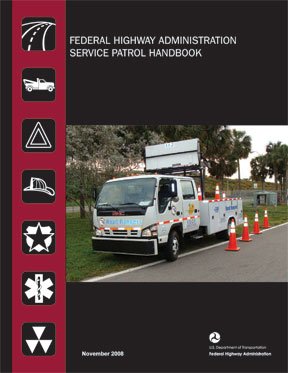Hard copies will not be available until late 2009 but you may continue to write to be added to our mailing list.

In the meantime the Printable Version [PDF 3.12 MB] is available for downloading.
Contact Information: Operations Feedback at OperationsFeedback@dot.gov
Notice
This document is disseminated under the sponsorship of the department of transportation in the interest of information exchange. The United States Government assumes no liability for its contents or use thereof. This report does not constitute a standard, specification, or regulation.
The United States Government does not endorse products or manufacturers. Trade and manufacturers’ names appear in this report only because they are considered essential to the object of the document.
Preface
This Handbook provides an overview of the Full-Function Service Patrol (FFSP) and describes desired program characteristics from the viewpoint of an agency that is responsible for funding, managing, and operating the services. Presented guidelines and rules of thumb illustrate operational characteristics, sponsorship, level of service, number of vehicles needed, vehicle types and equipment, patrol frequency, operator and manager training, and services provided. The primary audience for the Handbook comprises State department of transportation (DOT) decision-makers, managers, operators, and practitioners who are responsible for, or are considering, implementing an FFSP program as part of a strategy to reduce congestion.
The Federal Highway Administration (FHWA) encourages the largest metropolitan jurisdictions and their States to establish or upgrade service patrols to the standards outlined in this Handbook and to establish an FFSP program to provide a frequency of coverage that supports statewide incident clearance goals. This includes integration of the FFSP with regional traffic management center (TMC) operations so the patrol can be readily dispatched to incident locations as needed. The FFSP program functions will also include typical services currently provided in many programs today, such as providing minor repairs and motorist assistance, debris removal, providing fuel, providing first aid, pushing vehicles out of travel lanes, and assisting emergency services at crash scenes. An FFSP program is anticipated to reduce traffic congestion, improve travel time reliability, and improve safety on freeway and arterial systems in support of the U.S. Department of Transportation’s (U.S. DOT’s) National Strategy to Reduce Congestion on America’s Transportation Network (Congestion Initiative). Also, the program is expected to be consistent with the objectives of the National Traffic Incident Management Coalition’s (NTIMC’s) National Unified Goal (NUG) for Traffic Incident Management (TIM).
Technical Report Documentation Page
Table of Contents
Chapter 1 Overview
Chapter 2 Current Service Patrol Situational Analysis
2.1 Background, Objectives, and Scope
2.1.1 Traffic Congestion Trends
2.1.2 Growth of Service Patrol Programs
2.1.3 Benefits and Services of Service Patrols
2.1.4 Fundamental Components of a Service Patrol
2.1.5 Need for Consistency
2.2 Description of Current Service Patrols and Operational Constraints
2.2.1 Typical Services
2.2.2 Examples of Service that Range Beyond the Typical
2.2.3 Most Common Hours of Operation
2.2.4 Resources Typically Found with Current Service Patrols
2.2.5 Personnel Found on Today’s Service Patrols
2.2.6 Public Private Partnerships
2.2.7 Limitations
2.3 User Profiles/Classifications
2.3.1 State and Local Transportation Agencies
2.3.2 State and Local Law Enforcement
2.3.3 Fire and Rescue Services
2.3.4 Towing and Recovery Companies
2.3.5 Public and Private Information Services
2.3.6 Travelers and Other Users
2.4 Support Environment
2.4.1 Oversight
2.4.2 Facilities and Equipment
2.4.3 Communications
2.4.4 Funding
2.4.5 Contracting Mechanisms
2.4.6 Standard Operating Procedures and Guidelines
2.4.7 MOUs and Mutual-Aid Agreements
2.4.8 Outreach and Calling for Service
2.4.9 Summary
Chapter 3 Full-Function Service Patrol Justification and Nature of Changes
3.1 Justification
3.1.1 The Congestion Initiative
3.1.2 How Service Patrols Aid Transportation
3.1.3 Measuring Performance – Service Patrol
3.1.4 Measuring Performance – Contract Service Patrols
3.1.5 Benefit-Cost Ratio
3.1.6 Strategic Highway Safety Planning and Other Initiatives
3.1.7 Department of Homeland Security Mandate
3.1.8 Other Functions or Needs Service Patrols Fill
3.2 Changes Required for Migration to Full-Function Service Patrol
3.2.1 Overview of Baseline, Mid-level, and Full-Function Service Patrols
3.2.2 Fundamental Functional Needs
3.2.3 Personnel Needs
3.2.4 Operations Needs
3.2.5 Support Needs
3.3 Change Priorities
3.3.1 Essential Features
3.3.2 Desired Features
3.3.3 Optional Features
3.4 Changes Considered but not Included
3.5 Assumptions and Constraints
Chapter 4 Full-Function Service Patrol Concept
4.1 Background, Objectives, and Scope of an FFSP
4.2 Operational Policies and Constraints
4.2.1 Funding
4.2.2 Public Private Partnership
4.2.3 Educating Decision-Makers and Stakeholders
4.2.4 Institutional Coordination
4.2.5 Operational Policies and Program Cost
4.2.6 Program Administration and Operational Roles
4.2.7 Towing Company Constraints
4.3 Description of Full-Function Service Patrols
4.3.1 Hours of Operation
4.3.2 Service Area
4.3.3 Frequency of Coverage
4.3.4 Guidelines for Developing Vehicle Requirements
4.3.5 Guidelines for Developing Equipment Requirements
4.3.6 FFSP Operator Visibility Requirements and Apparel
4.3.7 Procedural Development Guidelines
4.3.8 Initial Operator Qualifications
4.3.9 Operator Certifications and Training
4.3.10 Costs
4.3.11 Communications and Dispatching
4.3.12 Automatic Vehicle Location
4.3.13 Record Keeping
4.3.14 Emergency Temporary Traffic Control
4.3.15 Suggested Emergency Traffic Control Procedures
4.3.16 National Incident Management System / Incident Command System
4.3.17 Program Performance Monitoring
4.4 Modes of Operation
4.4.1 Disaster Preparedness
4.4.2 Planned Special Events
4.5 User Involvement, Interaction, Roles, and Responsibilities
4.6 Support Environment
4.7 Incremental Priorities
Chapter 5 Service Patrol Telephone Survey Results
5.1 Introduction
5.2 Program Initiation and Funding
5.3 Functions and Field Operating Characteristics
5.4 Benefits and Lessons Learned
Chapter 6 Glossary of Abbreviations and Terms
Chapter 7 Referenced Documentation
7.1 Interviews, Questionnaires, and Research
7.2 Service Patrol Ride-Along
7.3 Resources and Documentation
List of Figures
Figure 1. Congestion Trends in U.S. Cities
Figure 2. The Sources of Congestion – National Summary

U.S. Department of Transportation
Federal Highway Administration
Office of Operations
1200 New Jersey Avenue, SE
Washington, DC 20590
www.ops.fhwa.dot.gov
July 9, 2008
Publication #FHWA-HOP-08-031
